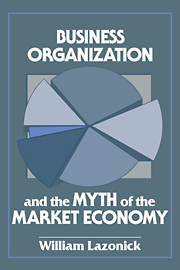Book contents
- Frontmatter
- Contents
- List of figures
- Acknowledgments
- Introduction: the wealth of three nations
- PART I Economic institutions and economic performance
- PART II Intellectual foundations and intellectual constraints
- PART III The “marvels of the market” versus the “visible hand”
- 6 The innovative business organization and transaction cost theory
- 7 Lending the economic institutions of capitalism a visible hand
- PART IV Overcoming intellectual constraints
- Index
6 - The innovative business organization and transaction cost theory
Published online by Cambridge University Press: 01 April 2010
- Frontmatter
- Contents
- List of figures
- Acknowledgments
- Introduction: the wealth of three nations
- PART I Economic institutions and economic performance
- PART II Intellectual foundations and intellectual constraints
- PART III The “marvels of the market” versus the “visible hand”
- 6 The innovative business organization and transaction cost theory
- 7 Lending the economic institutions of capitalism a visible hand
- PART IV Overcoming intellectual constraints
- Index
Summary
History and theory
Far from serving as a “highly specialized surrogate market,” as the market mentality leads Alchian and Demsetz to contend, the capitalist enterprise represents attempts by individuals to gain a measure of control over market forces through the ownership of productive resources other than their own labor power. As elaborated in Chapter 2, entrepreneurial individuals invest in their own firms so that they will not be dependent on the labor market to earn a living.
The history of capitalist enterprise also shows that in order to ensure the continuity of control over the productive assets in which they have invested, entrepreneurs avoid reliance on impersonal capital markets until they have transformed their firms from new ventures into going concerns – that is, firms that are generating sufficient value to finance internally their current operations. It is on the basis of this privileged access to productive and financial resources that the industrial capitalist becomes willing and able to seek funds from the capital market to finance further expansion.
It is also on the basis of control over a going concern that owner-entre-preneurs can monetize the value of their past investments by selling shares to the wealthholding public while handing over de facto control of their enterprises to career managers. As the historical argument in Chapter 1 shows, the successful transformation of a proprietary firm into a managerial enterprise required that managers, and not those who had acquired ownership by virtue of stock-market investments, retain privileged access to the organization's financial resources.
- Type
- Chapter
- Information
- Business Organization and the Myth of the Market Economy , pp. 191 - 227Publisher: Cambridge University PressPrint publication year: 1992
- 1
- Cited by



